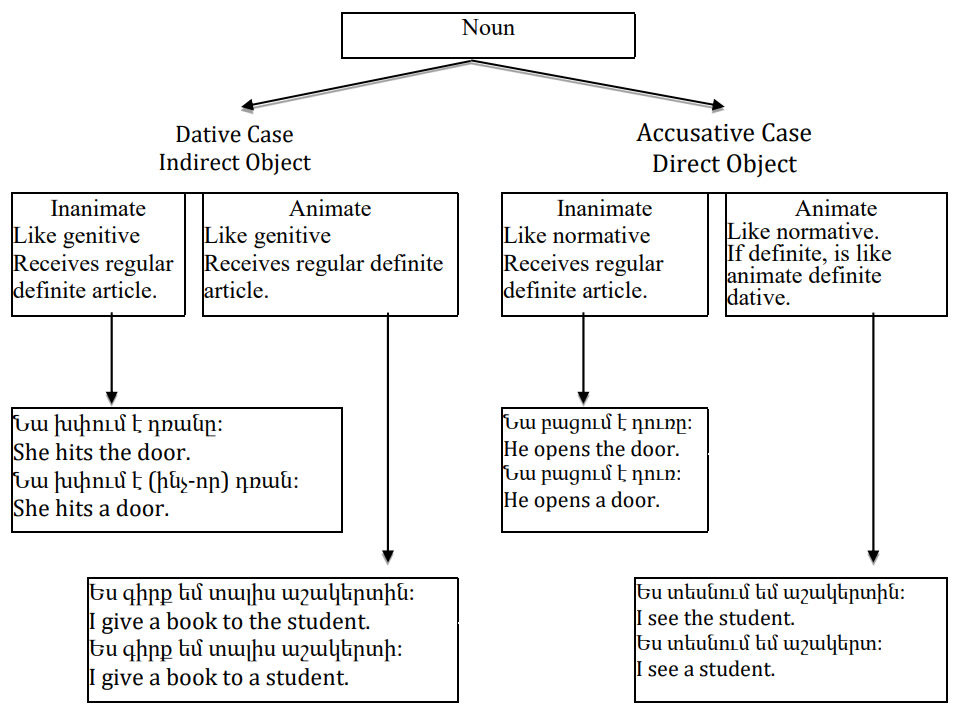Language/Armenian/Grammar/The-Dative-and-Accusative-Cases
In some cases, the genitive case encompasses both the dative and accusative cases. However, for the purpose of our discussion, we will treat them separately. It is important to distinguish between these cases because nouns in each case fulfill distinct roles within sentences. Additionally, personal pronouns exhibit unique forms in these cases that differ from the normative and genitive forms.
These cases primarily relate to the objects within a sentence. The dative case is used for indirect objects, while the accusative case is used for direct objects. Nouns in the dative case have the same form as those in the genitive case.
Nouns in the accusative case have the same form as those in the normative case. However, when referring to animate definite objects, direct objects acquire the ending "-ին". The following chart provides a summary of the roles and formation of these cases:
First lets discuss the dative case. Consider following sentences:
- Երեխան նայում է պատին։ The child looks at the wall.
- Մենք մոտենում ենք փողոցին։ We approach the street.
- Դուք հետևում եք բժշկին։ You follow the doctor.
Think of “-ն” in “-ին” as a definite article that the noun in genitive receives. Compare the just mentioned sentences with the following:
- Երեխան նայում է պատի։ The child looks at a wall.
- Մենք մոտենում ենք փողոցի։ We approach to a street.
- Դուք հետևում եք բժշկի։ You follow a doctor.
In these sentences պատի(ն), փողոցի(ն) and բժշկի(ն) are in dative case.The following verbs take indirect objects, which stand in dative.
| Armenian | English |
|---|---|
| ծանոթացնել | to acquaint |
| նստել | to sit on |
| ծառայել | to serve |
| պառկել | to lie down |
| կարոտել | to miss |
| պատասխանել | to answer |
| հաղթել | to win |
| պատկանել | to belong |
| հավատալ | to believe |
| սիրահարվել | to fall in love |
| հարվածել | to hit, kick |
| վստահել | to trust |
| հետևել | to follow |
| օգնել | to help |
| մոտենալ | to approach |
| հնազանդվել | to obey |
| նայել | to look |
- Նա միշտ օգնում է դպրոցին: He always helps the school.
- Մենք հնազանդվում ենք օրենքին: We obey the law.
BUT
- Նա միշտ օգնում է ինչ-որ դպրոցի։ He always helps some school.
- Մենք հնազանդվում ենք ինչ-որ օրենքի։ We obey some law.
The rules of formation of the dative are not only for nouns with regular -ի declension. These rules work also for nouns with irregular genitive forms. Here are some examples:
- Ես սիրում եմ իմ հորը: I love my father.
- Նա միշտ հավատում է իր կնոջը: He always believes his wife.
- Այս շենքը պատկանում է մարդկանց։ This building belongs to people.
The dative ending is used for adverbials of place like “on the wall” and “on the way,” and adverbials of time “at seven” “in January.” Here are a few examples:
- Նկարը պատին է: The picture is on the wall.
- Ես միշտ քնում եմ ճանապարհին: I always sleep on the way.
- Ինձ զանգու՞մ ես ժամը յոթին: Are you calling me at seven?
- Հունվարին ցուրտ է: It is cold in January.
Let us turn to the accusative case. As indicated in the chart above nouns that have the role of direct objects stand in accusative case.
The following verbs take direct objects, which stand in accusative.
| Armenian | English |
|---|---|
| ստանալ | to receive |
| տեսնել | to see |
| սովորել | to study |
| վերցնել | to take |
| դնել | to put, to put down |
| տանել | to carry, take away |
| սկսել | to begin |
| ավարտել | to finish |
| գրել | to write |
| ջնջել | to erase |
| վազել | to run |
| կառուցել | to build |
Examples:
- Նա սկսում է գործը։ She begins the work.
- Դու չես սովորում դասը։ You do not learn the lesson.
- Մենք չենք ստանում դրամ։ We do not receive money.
- Դուք տանում եք պայուսակ։ You carry a bag.
Notice that the nouns գործը, դասը, դրամ, պայուսակ are in accusative although they have the form of the normative case. When the direct object is an animate object and definite, the word accepts the form of definite animate dative.
Examples:
- Դուք չեք տեսնում բժշկին։ You do not see the doctor.
- Նրանք չեն տանում երեխային։ They do not carry the child.
- Մենք ստանում ենք պատանդներին։ We receive the hostages.
But
Whenever the direct object is an animate object and indefinite, the noun is in the normative case, not genitive unlike in dative case.
- Դուք չեք տեսնում բժիշկ։ You do not see a doctor.
- Նրանք չեն տանում երեխա։ They do not carry a child.
- Մենք ստանում ենք պատանդներ։ We receive some hostages
Sources[edit | edit source]
https://slaviccenters.duke.edu/sites/slaviccenters.duke.edu/files/handbook_of_armenian.pdf
Other Lessons[edit | edit source]
- Adjectives
- Nouns
- The Past Perfect Tense
- The Genitive Case
- Conjunctions
- Word Order
- The Ablative Case
- The Passive and Active Voice
- The Present Perfect Tense
- Cases of Nouns


